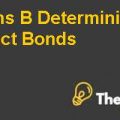Newfield Energy Case SolutionProblems/Opportunities in Case
In the start of September 2013, the Chairman of the board and the CEO of New field Energy was considering putting a financial proposal in front of the board of directors. However, before that he wanted the CFO of the company to approve the financial proposals. Newfield Energy is one of the independent and large energy companies which are based in Houston, Texas. The company has a long profitable history and the share price of the company has reached the highest of all time in the past. The company has also paid huge dividends to its shareholders.
However, recently, the earnings of the company had started to decline and the share price of the company had declined from a high level of $ 70 per share in 2007 to around $ 40 per share in September 2013. The main reason for this dramatic decline in the performance of the company and its declining performance in the stock market was the prolonged decline in the prices of the natural gas after the year 2009. This was partly due to new technologies being introduced for developing and exploring the natural gas.
Therefore, in order to counter these issues, Griffin had formulated a proposal through which first he wanted to launch a press release and inform all the investors and the public that the management of the company was planning to divest most of its natural gas plants and cut natural gas production. Secondly, there was a reduction in the stock dividends for the common stock holders and thirdly, he had planned an exchange offer under which 20% of the common stock shares would be converted into preferred stock shares offering a preferred dividend of $2 per share. An analysis needs to be performed and recommendations need to be made to opt for the best course of action.
Critical Evaluation of Case
As a result of the decline in the performance of the company, Griffin had started to lose his confidence in the growth of the company and its profitability, which the company was generating from its 60% natural gas production. Furthermore, the company had divested many natural gas assets and had started to make significant investments in several NGL and oil assets. More plans were made to invest in liquid rich assets and divest three more plants associated with natural gas production.
Overall, the company had faced a dramatic decline in its earnings and stock price. Also, the company was burdened with high debt loan, which the company was facing difficult to finance because of the declining earnings. Therefore, in response to this huge decline in the performance of the company, Griffin had formulated a proposal consisting of three parts as described previously. The most critical of all the three proposals was the cutting of the dividend from $ 2 per share to around $ 1 per share. A reduction in the dividend might discourage the potential investors from investing in the shares of the company in the future.
Griffin had also made a reduction in the dividend in the year 2009 and it did not cause a decline in the stock price during that period and the only reason for that was that all the institutional investors were informal about the potential dividend cut and as a result the dividend cut did not cause the share price to decline. However, the situation faced by the company was not similar and the investors of the company were not at all aware about the current situation and the reasons for reducing the share price of the company. Among the 1005 investors of the company, 65% of the total outstanding shares were held by 20 largest institutional investors, which included mutual funds, large corporations, commercial banks, investment banks etc.
Within these 65%, the 20% of the investors, which comprised of three corporations and five fund managers, had clearly mentioned that they relied on their dividend yield which was their primary objective of holding the shares in New field. Therefore, now if at this point of time a dividend cut is announced, then these 20% investors would be more likely to divest their investment in New field. If we look at the performance of the company prior to 2009, then it could be seen from the common size income statement, common size balance sheet and share price growth that it was following an increasing trend, however, now the situation had worsened and cutting division was one of the best options to cover for the losses the company was facing. The natural gas revenue between 2009 and 2010 had dropped significantly as shown in the appendix in spreadsheet. Therefore, the decision was critical however, it was all in the favor of the future earnings, profitability and the share price growth of New field Energy...........................................
This is just a sample partial case solution. Please place the order on the website to order your own originally done case solution.













